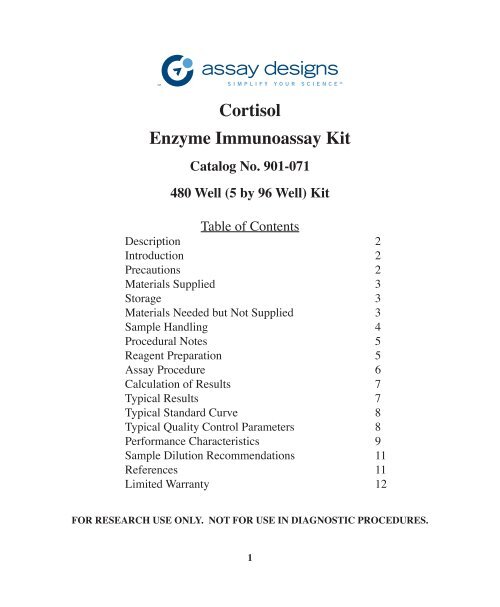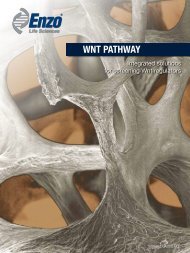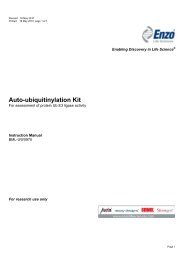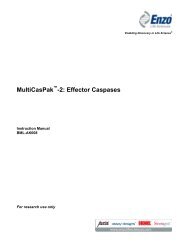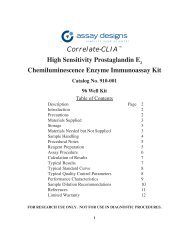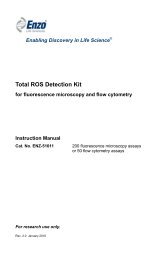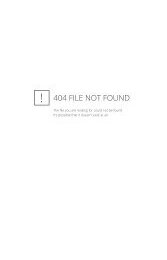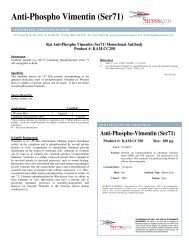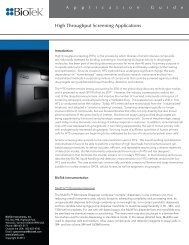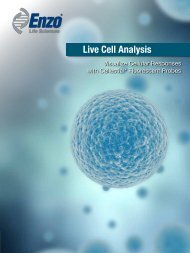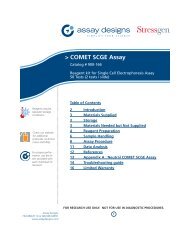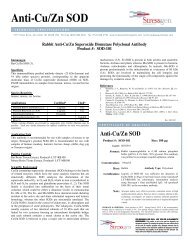Cortisol Enzyme Immunoassay Kit - Enzo Life Sciences
Cortisol Enzyme Immunoassay Kit - Enzo Life Sciences
Cortisol Enzyme Immunoassay Kit - Enzo Life Sciences
You also want an ePaper? Increase the reach of your titles
YUMPU automatically turns print PDFs into web optimized ePapers that Google loves.
Procedural Notes1. Do not mix components from different kit lots or use reagents beyond the kit expirationdate.2. Allow all reagents to warm to room temperature for at least 30 minutes before opening.3. Standards can be made up in either glass or plastic tubes.4. Pre-rinse the pipet tip with reagent, use fresh pipet tips for each sample, standard and reagent.5. Pipet standards and samples to the bottom of the wells.6. Add the reagents to the side of the well to avoid contamination.7. This kit uses break-apart microtiter strips, which allow the user to measure as manysamples as desired. Unused wells must be kept desiccated at 4 °C in the sealed bag provided.The wells should be used in the frame provided.8. Care must be taken to minimize contamination by endogenous alkaline phosphatase.Contaminating alkaline phosphatase activity, especially in the substrate solution, may leadto high blanks. Care should be taken not to touch pipet tips and other items that are usedin the assay with bare hands.9. Prior to addition of substrate, ensure that there is no residual wash buffer in wells.Any remaining wash buffer may cause variation in assay results.Reagent Preparation1. Assay BufferJust before use, prepare the assay buffer by diluting 10 mL of the supplied Assay BufferConcentrate with 90 mL of deionized water. Discard unused buffer or add up to 0.09%sodium azide (w/v) for storage.2. <strong>Cortisol</strong> StandardAllow the 100,000 pg/mL <strong>Cortisol</strong> standard solution to warm to room temperature. Labelseven 12 x 75 mm glass tubes #1 through #7. Pipet 1,000 µL of standard diluent (AssayBuffer or Tissue Culture Media) into tube #1. Pipet 500 µL of standard diluent into tubes#2 through #7. Remove 100 µL of diluent from tube #1. Add 100 µL of the 100,000 pg/mLstandard to tube #1. Vortex thoroughly. Add 500 µL of tube #1 to tube #2 and vortex thoroughly.Add 500 µL of tube #2 to tube #3 and vortex. Continue this for tubes #4 through#7.The concentration of <strong>Cortisol</strong> in tubes #1 through #7 will be 10,000, 5,000, 2,500, 1,250,625, 313 and 156 pg/mL respectively. See <strong>Cortisol</strong> Assay Layout Sheet for dilutiondetails.Diluted standards should be used within 60 minutes of preparation.3. Wash BufferPrepare the Wash Buffer by diluting 5 mL of the supplied concentrate with 95 mL of deionizedwater. This can be stored at room temperature until the kit expiration date, or for 3months, whichever is earlier.
Calculation of ResultsSeveral options are available for the calculation of the concentration of <strong>Cortisol</strong> in the samples. Werecommend that the data be handled by an immunoassay software package utilizing a 4 parameterlogistic curve fitting program. If this sort of data reduction software is not readily available, theconcentration of <strong>Cortisol</strong> can be calculated as follows:1. Calculate the average net Optical Density (OD) bound for each standard and sample bysubtracting the average NSB OD from the average OD bound:Average Net OD = Average Bound OD - Average NSB OD2. Calculate the binding of each pair of standard wells as a percentage of the maximum bindingwells (Bo), using the following formula:Percent Bound = Net OD x 100Net Bo OD3. Using Logit-Log paper plot Percent Bound versus Concentration of <strong>Cortisol</strong> for the standards.Approximate a straight line through the points. The concentration of <strong>Cortisol</strong> in theunknowns can be determined by interpolation.Typical ResultsThe results shown below are for illustration only and should not be used to calculate results fromanother assay.Mean Average Percent <strong>Cortisol</strong>Sample OD (-Blank) Net OD Bound (pg/mL)Blank OD (0.077)TA 0.307NSB 0.001 0.000 0.0Bo 0.816 0.815 100% 0S1 0.105 0.104 12.9% 10,000S2 0.158 0.157 19.3% 5,000S3 0.248 0.247 30.4% 2,500S4 0.365 0.364 44.7% 1,250S5 0.482 0.481 59.1% 625S6 0.588 0.587 72.1% 313S7 0.676 0.675 82.9% 156Unknown 1 0.260 0.259 31.8% 2,311Unknown 2 0.462 0.461 56.6% 702
Typical Standard CurveA typical standard curve is shown below. This curve must not be used to calculate <strong>Cortisol</strong> concentrations;each user must run a standard curve for each assay.Typical Quality Control ParametersTotal Activity Added = 0.307 x 10 = 3.07%NSB = 0.03%%Bo/TA = 26.58%Quality of Fit = 1.0020% Intercept = 4919 pg/mL50% Intercept = 957 pg/mL80% Intercept = 192 pg/mL
PrecisionIntra-assay precision was determined by taking samples containing low, medium and high concentrationsof <strong>Cortisol</strong> and running these samples multiple times (n=16) in the same assay. Inter-assayprecision was determined by measuring three samples with low, medium and high concentrations of<strong>Cortisol</strong> in multiple assays (n=8).The precision numbers listed below represent the percent coefficient of variation for the concentrationsof <strong>Cortisol</strong> determined in these assays as calculated by a 4 parameter logistic curve fittingprogram.<strong>Cortisol</strong> Intra-assay Inter-assay(pg/mL) %CV %CVLow 333 10.5Medium 1,088 6.6High 3,155 7.3Low 451 13.4Medium 969 7.8High 3,052 8.6Cross ReactivityThe cross reactivities for a number of related steroid compounds was determined by dissolving thecross reactant (purity checked by N.M.R. and other analytical methods) in Assay Buffer at concentrationsfrom 100,000 to 10 pg/mL. These samples were then measured in the <strong>Cortisol</strong> assay, andthe measured <strong>Cortisol</strong> concentration at 50% B/Bo was calculated. The % cross reactivity was calculatedby comparison with the actual concentration of cross reactant in the sample and expressedas a percentage.CompoundCross Reactivity<strong>Cortisol</strong> 100%Prednisolone 122%Corticosterone 27.7%11-deoxycortisol 4.0%Progesterone 3.64%Prednisone 0.85%Testosterone 0.12%Androstenedione
Sample Recoveries<strong>Cortisol</strong> concentrations were measured in a variety of different samples including tissue culture media,human saliva and urine, and porcine serum and plasma. For samples in tissue culture media, ensurethat the standards have been diluted into the same media (refer to page 4). <strong>Cortisol</strong> was spiked intothe undiluted samples of these media which were then diluted with the kit Assay Buffer and thenassayed in the kit. The following results were obtained:Sample % Recovery* Recommended Dilution*Tissue Culture Media 106.6 NeatHuman Saliva 97.4 ≥1:4Human Urine 102.2 NonePorcine Serum 103.8 ≥1:8Porcine Plasma 106.1 ≥1:8* See Sample Handling instructions on page 4 for details.References1. T. Chard,”An Introduction to Radioimmunoassay & Related Techniques 4th Ed”, (1990)Amsterdam: Elsevier.2. P. Tijssen,”Practice & Theory of <strong>Enzyme</strong> <strong>Immunoassay</strong>s”, (1985) Amsterdam: Elsevier.3. E. Friess, et al., Eur J Clin Invest, (2000) 30 Suppl 3:46-50.4. C. Longscope., J Endocrinology, (1996) 150 Suppl: S125-S127.5. J. Herbert, Lancet, (1995) 345:1193-1194.6. A. Michael, et al., Biol. Psychiatry, (2000) 48(10): 989-95.7. C.R. Dequet and D.J. Wallace, Current Opin Ivest Drugs, (2001) 8: 1045-53.8. W.M. Jeffries, Med Hypotheses, (1998) 51(2):111-4.9. National Committee for Clinical Laboratory Standards Evaluation Protocols, SC1, (1989)Villanova, PA: NCCLS.11
LIMITED WARRANTYAssay Designs, Inc. warrants that at the time of shipment this product is free from defects in materialsand workmanship. This warranty is in lieu of any other warranty expressed or implied, including butnot limited to, any implied warranty of merchantability or fitness for a particular purpose.Assay Designs must be notified of any breach of this warranty within 48 hours of receipt of theproduct. No claim shall be honored if Assay Designs is not notified within this time period, or if theproduct has been stored in any way other than outlined in this publication. The sole and exclusiveremedy of the customer for any liability based upon this warranty is limited to the replacement ofthe product, or refund of the invoice price of the goods.For more details concerning the information within this kit insert, or to orderany of Assay Designs’ products, please call (734) 668-6113 between 8:30 a.m.and 5:30 p.m. EST. Orders or technical questions can also be transmitted byfax or e-mail 24 hours a day.Material Safety Data Sheet (MSDS) available on our website or by fax.Assay Designs, Inc. Telephone: (734) 668-61135777 Hines Drive (800) 833-8651 (USA & Canada only)Ann Arbor, MI 48108 Fax: (734) 668-2793U.S.A. e-mail: info@assaydesigns.comwebsite: www.assaydesigns.comSimplify Your Science ®Catalog No. 25-0359 January 22, 2008© 200112


